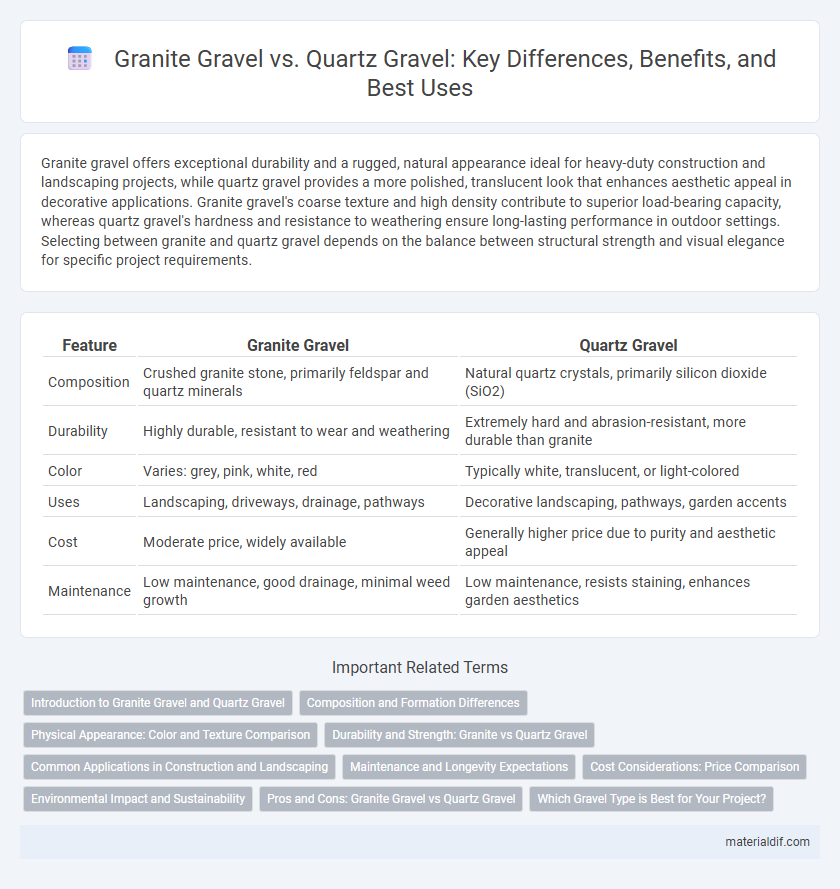Granite gravel offers exceptional durability and a rugged, natural appearance ideal for heavy-duty construction and landscaping projects, while quartz gravel provides a more polished, translucent look that enhances aesthetic appeal in decorative applications. Granite gravel's coarse texture and high density contribute to superior load-bearing capacity, whereas quartz gravel's hardness and resistance to weathering ensure long-lasting performance in outdoor settings. Selecting between granite and quartz gravel depends on the balance between structural strength and visual elegance for specific project requirements.
Table of Comparison
| Feature | Granite Gravel | Quartz Gravel |
|---|---|---|
| Composition | Crushed granite stone, primarily feldspar and quartz minerals | Natural quartz crystals, primarily silicon dioxide (SiO2) |
| Durability | Highly durable, resistant to wear and weathering | Extremely hard and abrasion-resistant, more durable than granite |
| Color | Varies: grey, pink, white, red | Typically white, translucent, or light-colored |
| Uses | Landscaping, driveways, drainage, pathways | Decorative landscaping, pathways, garden accents |
| Cost | Moderate price, widely available | Generally higher price due to purity and aesthetic appeal |
| Maintenance | Low maintenance, good drainage, minimal weed growth | Low maintenance, resists staining, enhances garden aesthetics |
Introduction to Granite Gravel and Quartz Gravel
Granite gravel consists of coarse, angular fragments derived from the igneous rock granite, known for its durability and strength in construction and landscaping applications. Quartz gravel is composed primarily of quartz mineral particles, offering high abrasion resistance and a lighter color that enhances aesthetic appeal in decorative uses. Both types of gravel vary in hardness, texture, and mineral composition, influencing their suitability for specific projects such as driveways, paths, and drainage systems.
Composition and Formation Differences
Granite gravel consists primarily of quartz, feldspar, and mica, formed through the slow crystallization of magma beneath the Earth's surface, resulting in a coarse-grained texture. Quartz gravel is predominantly made of nearly pure quartz crystals, usually formed through sedimentary processes involving weathering and erosion of quartz-rich rocks, leading to rounded, smooth particles. The compositional difference lies in granite gravel's mixed mineral content versus quartz gravel's high silica purity, while formation differences stem from igneous origin versus sedimentary re-deposition.
Physical Appearance: Color and Texture Comparison
Granite gravel features a diverse color palette including shades of gray, pink, and white, with a coarse, speckled texture due to the interlocking crystals of quartz, feldspar, and mica. Quartz gravel typically displays a more uniform appearance, predominantly white or translucent, with a smooth, glassy texture that reflects light. The color variation and rough texture of granite gravel make it visually distinct from the cleaner, brighter, and more polished look of quartz gravel.
Durability and Strength: Granite vs Quartz Gravel
Granite gravel exhibits superior durability and strength due to its high quartz and feldspar content, which provides excellent resistance to abrasion and weathering. In contrast, quartz gravel, while hard, tends to be more brittle and less resistant to fracturing under heavy loads. Consequently, granite gravel is preferred for heavy-duty construction and landscaping projects requiring long-lasting performance.
Common Applications in Construction and Landscaping
Granite gravel is widely used in construction for durable road base materials, concrete aggregate, and drainage systems due to its hardness and resistance to weathering. Quartz gravel, known for its high silica content and smooth texture, is preferred in landscaping for decorative pathways, garden beds, and water features, offering aesthetic appeal and reflectivity. Both materials provide excellent permeability and stability, making them suitable for erosion control and foundational support in various outdoor projects.
Maintenance and Longevity Expectations
Granite gravel offers superior durability and low maintenance due to its hardness and resistance to weathering, making it ideal for long-lasting landscaping projects. Quartz gravel, while visually appealing with its translucent and varied hues, tends to be softer and more prone to surface wear, requiring more frequent upkeep. Longevity expectations favor granite gravel for heavy-traffic areas, whereas quartz gravel suits decorative uses with moderate maintenance needs.
Cost Considerations: Price Comparison
Granite gravel typically costs between $30 to $50 per ton, reflecting its durability and widespread availability, while quartz gravel can range from $40 to $70 per ton due to its unique hardness and aesthetic appeal. Price fluctuations depend on factors such as quarry location, transportation costs, and processing methods. Choosing between granite and quartz gravel involves balancing budget constraints with desired material properties for specific landscaping or construction projects.
Environmental Impact and Sustainability
Granite gravel has a lower environmental impact due to its greater durability and resistance to weathering, reducing the need for frequent replacement and minimizing waste. Quartz gravel, while visually appealing, tends to break down faster, increasing erosion and sediment runoff risks that can harm local ecosystems. Sustainable sourcing of granite gravel often involves recycled or locally quarried material, further diminishing carbon emissions compared to the typically higher extraction footprint of quartz gravel.
Pros and Cons: Granite Gravel vs Quartz Gravel
Granite gravel offers superior durability and resistance to weathering, making it ideal for heavy-duty landscaping and construction projects, but it can be heavier and more expensive than quartz gravel. Quartz gravel provides excellent aesthetic appeal with its bright, translucent appearance and tends to be lighter and more affordable, yet it is less durable and more prone to chipping and scratching under heavy use. Choosing between granite and quartz gravel depends on the specific requirements for strength, cost, and visual impact in your project.
Which Gravel Type is Best for Your Project?
Granite gravel offers superior durability and resistance to weathering, making it ideal for heavy-duty construction and landscaping projects requiring long-lasting materials. Quartz gravel, known for its high silica content and reflective properties, provides excellent drainage and aesthetic appeal, especially in decorative pathways and garden beds. Choosing between granite and quartz gravel depends on project needs, where granite suits structural applications and quartz excels in visual enhancement and water permeability.
Granite Gravel vs Quartz Gravel Infographic

 materialdif.com
materialdif.com